Land Cover Change in Northern Botswana: The Influence of Climate, Fire, and Elephants on Semi-Arid Savanna Woodlands
Abstract
1. Introduction
2. Materials and Methods
2.1. Study Area
2.2. Land Use and Management
2.3. Data Sources
Climate and Wildlife Aerial Survey Data
2.4. Satellite Imagery Pre-Processing
2.5. Land Cover Classification
2.6. Classification Accuracy Assessment
2.7. Change Detection
2.8. Statistical Analysis
3. Results
3.1. Land Cover Classification Accuracy
3.2. Summary of Net LCC
3.2.1. Chobe District
3.2.2. Protected Areas and Communal Lands in the Chobe Enclave
3.3. Summary of Gross LCC
3.4. Rainfall
3.5. Spatiotemporal Analysis of Fire, Rainfall, and Woodland Loss
3.6. Geospatial Analysis of Fire Hot Spots
3.7. Spatial Analysis of Woodland Loss in Relation to Elephant Biomass in Aerial Survey Units
4. Discussion
4.1. Chobe District Net and Gross LCC
4.2. LCC in Protected Areas
4.3. Drivers of Land Cover Change
4.3.1. Rainfall and Fire
4.3.2. Woodland Change and Elephants
4.4. Fire Management Implications
4.5. Limitations
5. Conclusions
Supplementary Materials
Acknowledgments
Author Contributions
Conflicts of Interest
References
- Smith, R. Global Forest Resources Assessment 2000 Main Report; Food and Agriculture Organization: Rome, Italy, 2001. [Google Scholar]
- Unccd, Z.N.L.D. United Nations Convention to Combat Desertification. Available online: http://www2.unccd.int/ (accessed on 4 April 2014).
- Safriel, U.; Adeel, Z. Dryland Systems.‖ in Ecosystems and Human Well-Being: Current State and Trends; Hassan, R., Scholes, R., Ash, N., Eds.; Island Press: Washington, DC, USA, 2005; Volume 1, pp. 623–662. [Google Scholar]
- Safriel, U.; Adeel, Z. Development paths of drylands: Thresholds and sustainability. Sustain. Sci. 2008, 3, 117–123. [Google Scholar] [CrossRef]
- Huber-Sannwald, E.; Palacios, M.R.; Moreno, J.T.A.; Braasch, M.; Peña, R.M.M.; de Alba Verduzco, J.G.; Santos, K.M. Navigating challenges and opportunities of land degradation and sustainable livelihood development in dryland social-ecological systems: A case study from Mexico. Philos. Trans. R. Soc. B Biol. Sci. 2012, 367, 3158–3177. [Google Scholar] [CrossRef] [PubMed]
- Scholes, R.; Walker, B. Nylsvley: The Study of an African Savanna; Cambridge University Press: Cambridge, UK, 1993. [Google Scholar]
- Ryan, C.M.; Pritchard, R.; McNicol, I.; Owen, M.; Fisher, J.A.; Lehmann, C. Ecosystem services from Southern African woodlands and their future under global change. Philos. Trans. R. Soc. B 2016, 371, 20150312. [Google Scholar] [CrossRef] [PubMed]
- Joos-Vandewalle, S. The Effects of Urbanisation on Non-Timber Forest Product Dependencies: A Case Study of Three Settlements in the Chobe District of Northern Botswana; University of Cape Town: Cape Town, South Africa, 2015. [Google Scholar]
- Schuyt, K.D. Economic consequences of wetland degradation for local populations in Africa. Ecol. Econ. 2005, 53, 177–190. [Google Scholar] [CrossRef]
- Jones, B.T. Chobe enclave. In IUCN/SNV CBNRM Support Programme; Printing and Publishing Company: Botswana, Gabarone, 2002. [Google Scholar]
- Scholes, R. Syndromes of dryland degradation in Southern Africa. Afr. J. Range Forage Sci. 2009, 26, 113–125. [Google Scholar] [CrossRef]
- Dregne, H.; Kassas, M.; Rozanov, B. A new assessment of the world status of desertification. Desertification Control Bull. 1991, 20, 6–18. [Google Scholar]
- Wily, L.; Mbaya, S. Land, People, and Forests in Eastern and Southern Africa at the Beginning of the 21st Century: The Impact of Land Relations on the Role of Communities in Forest Future; No. 7; IUCN: Gland, Switzerland, 2001. [Google Scholar]
- Staver, A.C.; Archibald, S.; Levin, S. Tree cover in sub-saharan Africa: Rainfall and fire constrain forest and savanna as alternative stable states. Ecology 2011, 92, 1063–1072. [Google Scholar] [CrossRef] [PubMed]
- Sankaran, M.; Ratnam, J.; Hanan, N.P. Tree-grass coexistence in savannas revisited-insights from an examination of assumptions and mechanisms invoked in existing models. Ecol. Lett. 2004, 7, 480–490. [Google Scholar] [CrossRef]
- Ratnam, J.; Bond, W.J.; Fensham, R.J.; Hoffmann, W.A.; Archibald, S.; Lehmann, C.E.; Anderson, M.T.; Higgins, S.I.; Sankaran, M. When is a ‘forest’ a savanna, and why does it matter? Glob. Ecol. Biogeogr. 2011, 20, 653–660. [Google Scholar] [CrossRef]
- Walker, B.H.; Ludwig, D.; Holling, C.S.; Peterman, R.M. Stability of semi-arid savanna grazing systems. J. Ecol. 1981, 69, 473–498. [Google Scholar] [CrossRef]
- Walter, W.G.; Bottman, R.P. Microbiological and chemical studies of an open and closed watershed. J. Environ. Health 1967, 30, 157–163. [Google Scholar]
- Casper, B.B.; Jackson, R.B. Plant competition underground. Annu. Rev. Ecol. Syst. 1997, 28, 545–570. [Google Scholar] [CrossRef]
- Beckage, B.; Platt, W.J.; Gross, L.J. Vegetation, fire, and feedbacks: A disturbance-mediated model of savannas. Am. Nat. 2009, 174, 805–818. [Google Scholar] [PubMed]
- Sankaran, M.; Hanan, N.P.; Scholes, R.J.; Ratnam, J.; Augustine, D.J.; Cade, B.S.; Gignoux, J.; Higgins, S.I.; Le Roux, X.; Ludwig, F. Determinants of woody cover in African savannas. Nature 2005, 438, 846–849. [Google Scholar] [CrossRef] [PubMed]
- Higgins, S.I.; Bond, W.J.; Trollope, W.S. Fire, resprouting and variability: A recipe for grass-tree coexistence in savanna. J. Ecol. 2000, 88, 213–229. [Google Scholar] [CrossRef]
- Scholes, R.; Archer, S. Tree-grass interactions in savannas. Annu. Rev. Ecol. Syst. 1997, 28, 517–544. [Google Scholar] [CrossRef]
- Bond, W.; Midgley, G.; Woodward, F.; Hoffman, M.; Cowling, R. What controls South African vegetation—Climate or fire? S. Afr. J. Bot. 2003, 69, 79–91. [Google Scholar] [CrossRef]
- Baudena, M.; Dekker, S.C.; van Bodegom, P.M.; Cuesta, B.; Higgins, S.I.; Lehsten, V.; Reick, C.H.; Rietkerk, M.; Scheiter, S.; Yin, Z. Forests, savannas, and grasslands: Bridging the knowledge gap between ecology and dynamic global vegetation models. Biogeosciences 2015, 12, 1833–1848. [Google Scholar] [CrossRef]
- Scholes, R.; Dowty, P.; Caylor, K.; Parsons, D.A.B.; Frost, P.G.H.; Shugart, H. Trends in savanna structure and composition along an aridity gradient in the Kalahari. J. Veg. Sci. 2002, 13, 419–428. [Google Scholar] [CrossRef]
- Vetter, S. Zambezian Baikiaea Woodlands (at0726). Terrestrial Ecoregions Profiles. World Wildlife Fund. Available online: http://www.worldwildlife.org/wildworld/profiles/terrestrial/at/at0726_full.html (accessed on 4 April 2014).
- Lowrance, R.; Altier, L.S.; Newbold, J.D.; Schnabel, R.R.; Groffman, P.M.; Denver, J.M.; Correll, D.L.; Gilliam, J.W.; Robinson, J.L.; Brinsfield, R.B. Water quality functions of riparian forest buffers in chesapeake bay watersheds. Environ. Manag. 1997, 21, 687–712. [Google Scholar] [CrossRef]
- Anderson, H.W.; Hoover, M.D.; Reinhart, K.G. Forests and Water: Effects of Forest Management on Floods, Sedimentation, and Water Supply; USDA Forest Service: Berkely, CA, USA, 1976. [Google Scholar]
- Swift, M.J.; Heal, O.W.; Anderson, J.M. Decomposition in Terrestrial Ecosystems; University of California Press: Oakland, CA, USA, 1979; Volume 5. [Google Scholar]
- McCulley, R.L.; Archer, S.; Boutton, T.; Hons, F.; Zuberer, D. Soil respiration and nutrient cycling in wooded communities developing in grassland. Ecology 2004, 85, 2804–2817. [Google Scholar] [CrossRef]
- Bunting, E.; Steele, J.; Keys, E.; Muyengwa, S.; Child, B.; Southworth, J. Local perception of risk to livelihoods in the semi-arid landscape of Southern Africa. Land 2013, 2, 225–251. [Google Scholar] [CrossRef]
- Cui, X.; Gibbes, C.; Southworth, J.; Waylen, P. Using remote sensing to quantify vegetation change and ecological resilience in a semi-arid system. Land 2013, 2, 108–130. [Google Scholar] [CrossRef]
- Southworth, J.; Rigg, L.; Gibbes, C.; Waylen, P.; Zhu, L.; McCarragher, S.; Cassidy, L. Integrating dendrochronology, climate and satellite remote sensing to better understand savanna landscape dynamics in the Okavango delta, Botswana. Land 2013, 2, 637–655. [Google Scholar] [CrossRef]
- Herrero, H.V.; Southworth, J.; Bunting, E. Utilizing multiple lines of evidence to determine landscape degradation within protected area landscapes: A case study of Chobe national park, Botswana from 1982 to 2011. Remote Sens. 2016, 8, 623. [Google Scholar] [CrossRef]
- Vogel, M.; Strohbach, M. Monitoring of savanna degradation in Namibia using Landsat TM/ETM+ data. In Proceedings of the 2009 IEEE International Geoscience and Remote Sensing Symposium, Cape Town, South Africa, 12–17 July 2009; pp. III-931–III-934. [Google Scholar]
- Lehmann, C.E.; Archibald, S.A.; Hoffmann, W.A.; Bond, W.J. Deciphering the distribution of the savanna biome. New Phytol. 2011, 191, 197–209. [Google Scholar] [CrossRef] [PubMed]
- Wessels, K.; Prince, S.; Frost, P.; Van Zyl, D. Assessing the effects of human-induced land degradation in the former homelands of northern South Africa with a 1 km AVHRR NDVI time-series. Remote Sens. Environ. 2004, 91, 47–67. [Google Scholar] [CrossRef]
- Brink, A.B.; Eva, H.D. Monitoring 25 years of land cover change dynamics in Africa: A sample based remote sensing approach. Appl. Geogr. 2009, 29, 501–512. [Google Scholar] [CrossRef]
- Aleman, J.C.; Blarquez, O.; Staver, C.A. Land-use change outweighs projected effects of changing rainfall on tree cover in sub-saharan Africa. Glob. Chang. Biol. 2016, 22, 3013–3025. [Google Scholar] [CrossRef] [PubMed]
- Ministry of Environment Wildlife & Tourism. Forest Policy, Ministry of Environment, Wildlife, and Tourism; Botswana Government Printer: Gabarone, Botswana, 2011.
- Skarpe, C.; du Toit, J.; Moe, S.R. Elephants and Savanna Woodland Ecosystems: A Study from Chobe National Park, Botswana; John Wiley & Sons: Hoboken, NJ, USA, 2014. [Google Scholar]
- Simpson, C.D. A detailed vegetation study on the Chobe River in north-east Botswana. Kirkia 1975, 10, 185–227. [Google Scholar]
- Child, G. An Ecological Survey of Northeastern Botswana; Food and Agricultural Organization of the United Nations: Rome, Italy, 1968. [Google Scholar]
- Moe, S.R.; Rutina, L.P.; Hytteborn, H.; du Toit, J.T. What controls woodland regeneration after elephants have killed the big trees? J. Appl. Ecol. 2009, 46, 223–230. [Google Scholar] [CrossRef]
- Rutina, L.P.; Moe, S.R. Elephant (loxodonta africana) disturbance to riparian woodland: Effects on tree-species richness, diversity and functional redundancy. Ecosystems 2014, 17, 1384–1396. [Google Scholar] [CrossRef]
- Teren, G.; Owen-Smith, N. Elephants and riparian woodland changes in the Linyanti Region, Northern Botswana. Pachyderm 2010, 47, 18–25. [Google Scholar]
- Ben-Shahar, R. Patterns of elephant damage to vegetation in Northern Botswana. Biol. Conserv. 1993, 65, 249–256. [Google Scholar] [CrossRef]
- Mosugelo, D.K.; Moe, S.R.; Ringrose, S.; Nellemann, C. Vegetation changes during a 36-year period in northern Chobe National Park, Botswana. Afr. J. Ecol. 2002, 40, 232–240. [Google Scholar] [CrossRef]
- Fullman, T.J.; Bunting, E.L. Analyzing vegetation change in an elephant-impacted landscape using the moving standard deviation index. Land 2014, 3, 74–104. [Google Scholar] [CrossRef]
- Blanc, J.J. African Elephant Status Report 2007: An Update from the African Elephant Database; No. 33; IUCN: Gland, Switzerland, 2007. [Google Scholar]
- DWNP. Aerial Census of Wildlife and Some Domestic Animals in Botswana; Department of Wildlife and National Parks. Monitoring Unit, Research Division: Gaborone, Botswana, 2014. [Google Scholar]
- Secretariat of the convention on biological diversity. The Convention on Biological Diversity. In Global Biodiversity Outlook, 1st ed.; Secretariat of the Convention on Biological Diversity: Montreal, QC, Canada, 2001; pp. 119–136. [Google Scholar]
- Pricope, N.G.; Binford, M.W. A spatio-temporal analysis of fire recurrence and extent for semi-arid savanna ecosystems in Southern Africa using moderate-resolution satellite imagery. J. Environ. Manag. 2012, 100, 72–85. [Google Scholar] [CrossRef] [PubMed]
- Republic of Botswana. Population and Housing Census, 2011; Statistics Botswana: Gaborone, Botswana, 2011.
- Republic of Botswana. Botswana, National Conservation Strategy: National Policy on Natural Resources Conservation and Development; Gaborone Government Printer: Gaborone, Botswana, 1990.
- Giglio, L.; Kendall, J.; Mack, R. A multi-year active fire dataset for the tropics derived from the TRMM VIRS. Int. J. Remote Sens. 2003, 24, 4505–4525. [Google Scholar] [CrossRef]
- Justice, C.; Giglio, L.; Korontzi, S.; Owens, J.; Morisette, J.; Roy, D.; Descloitres, J.; Alleaume, S.; Petitcolin, F.; Kaufman, Y. The MODIS fire products. Remote Sens. Environ. 2002, 83, 244–262. [Google Scholar] [CrossRef]
- Giglio, L.; Descloitres, J.; Justice, C.O.; Kaufman, Y.J. An enhanced contextual fire detection algorithm for MODIS. Remote Sens. Environ. 2003, 87, 273–282. [Google Scholar] [CrossRef]
- Jolly, G. Sampling methods for aerial censuses of wildlife populations. East Afr. Agric. For. J. 1969, 34, 46–49. [Google Scholar]
- Boshoff, A.; Kerley, G.; Cowling, R. Estimated spatial requirements of the medium-to large-sized mammals, according to broad habitat units, in the Cape Floristic Region, South Africa. Afr. J. Range Forage Sci. 2002, 19, 29–44. [Google Scholar] [CrossRef]
- Kiage, L.; Liu, K.B.; Walker, N.; Lam, N.; Huh, O. Recent land-cover/use change associated with land degradation in the Lake Baringo catchment, Kenya, East Africa: Evidence from Landsat TM and ETM+. Int. J. Remote Sens. 2007, 28, 4285–4309. [Google Scholar] [CrossRef]
- Food and Agriculture Organization (FAO). Global Forest Resources Assessment 2010: Main Report; Food and Agriculture Organization of the United Nations: Rome, Italy, 2010. [Google Scholar]
- Congalton, R.G.; Green, K. Assessing the Accuracy of Remotely Sensed Data: Principles and Practices; CRC Press: Boca Raton, FL, USA, 2008. [Google Scholar]
- Kuhn, M. The Caret Package. R Foundation for Statistical Computing: Vienna, Austria. Available online: https://cran.r-project.org/package=caret (accessed on 21 September 2012).
- Pontius, R.G., Jr.; Millones, M. Death to kappa: Birth of quantity disagreement and allocation disagreement for accuracy assessment. Int. J. Remote Sens. 2011, 32, 4407–4429. [Google Scholar] [CrossRef]
- Pontius, R.G., Jr.; Santacruz, A. Quantity, exchange, and shift components of difference in a square contingency table. Int. J. Remote Sens. 2014, 35, 7543–7554. [Google Scholar] [CrossRef]
- Team, R.C. R: A Language and Environment for Statistical Computing [Internet]; R Foundation for Statistical Computing: Vienna, Austria, 2014. [Google Scholar]
- Pinheiro, J.; Bates, D.; DebRoy, S.; Sarkar, D.; R Core Team. NLME: Linear and Nonlinear Mixed Effects Models, R Package Version 3.1-117; 2014. Available online: http://CRAN.R-project.org/package=nlme (accessed on 20 September 2014).
- Griffis, V.; Stedinger, J. The use of GLS regression in regional hydrologic analyses. J. Hydrol. 2007, 344, 82–95. [Google Scholar] [CrossRef]
- Mayer, A.L.; Khalyani, A.H. Grass trumps trees with fire. Science 2011, 334, 188–189. [Google Scholar] [CrossRef] [PubMed]
- Bond, W.J.; Midgley, G.F. A proposed CO2-controlled mechanism of woody plant invasion in grasslands and savannas. Glob. Chang. Biol. 2000, 6, 865–869. [Google Scholar] [CrossRef]
- Bond, W.J.; Midgley, G.F. Carbon dioxide and the uneasy interactions of trees and savannah grasses. Philos. Trans. R. Soc. Lond. B Biol. Sci. 2012, 367, 601–612. [Google Scholar] [CrossRef] [PubMed]
- Lu, X.; Wang, L.; McCabe, M.F. Elevated co2 as a driver of global dryland greening. Sci. Rep. 2016, 6. [Google Scholar] [CrossRef] [PubMed]
- Milly, P.C.; Dunne, K.A.; Vecchia, A.V. Global pattern of trends in streamflow and water availability in a changing climate. Nature 2005, 438, 347–350. [Google Scholar] [CrossRef] [PubMed]
- Food and Agricultural Organization (FAO). Global Forest Resources Assessments 2015; FAO Forestry Paper No. 1; The Food and Agricultural Organization of the United Nations (FAO): Rome, Italy, 2015. [Google Scholar]
- Darkoh, M.B.; Mbaiwa, J.E. Okavango Delta-A Kalahari Oasis under environmental threats. J. Biodivers. Endanger. Species 2014, 2. [Google Scholar] [CrossRef]
- Guy, P. Changes in the biomass and productivity of woodlands in the Sengwa Wildlife Research Area, Zimbabwe. J. Appl. Ecol. 1981, 18, 507–519. [Google Scholar] [CrossRef]
- Cowling, R.M.; Richardson, D.M.; Pierce, S.M. Vegetation of Southern Africa; Cambridge University Press: Cambridge, UK, 2004. [Google Scholar]
- Pfeifer, M.; Burgess, N.D.; Swetnam, R.D.; Platts, P.J.; Willcock, S.; Marchant, R. Protected areas: Mixed success in conserving East Africa’s evergreen forests. PLoS ONE 2012, 7, e39337. [Google Scholar] [CrossRef] [PubMed]
- Willcock, S.; Phillips, O.L.; Platts, P.J.; Swetnam, R.D.; Balmford, A.; Burgess, N.D.; Ahrends, A.; Bayliss, J.; Doggart, N.; Doody, K. Land cover change and carbon emissions over 100 years in an African biodiversity hotspot. Glob. Chang. Biol. 2016, 22, 2787–2800. [Google Scholar] [CrossRef] [PubMed]
- Lepetu, J.; Alavalapati, J.; Nair, P. Forest dependency and its implication for protected areas management: A case study from kasane forest reserve, Botswana. Int. J. Environ. Res. 2010, 3, 525–536. [Google Scholar]
- Kgathi, D.; Sekhwela, M. Sustainability of the commercial exploitation and management of the chore forest reserves in Botswana. S. Afr. Geogr. J. 2003, 85, 26–34. [Google Scholar] [CrossRef]
- Thakadu, O. Success factors in community based natural resources management in Northern Botswana: Lessons from practice. Nat. Resour. Forum 2005, 29, 199–212. [Google Scholar] [CrossRef]
- Archibald, S.; Bond, W.; Stock, W.; Fairbanks, D. Shaping the landscape: Fire-grazer interactions in an African savanna. Ecol. Appl. 2005, 15, 96–109. [Google Scholar] [CrossRef]
- Staver, A.C.; Levin, S.A. Integrating theoretical climate and fire effects on savanna and forest systems. Am. Nat. 2012, 180, 211–224. [Google Scholar] [CrossRef] [PubMed]
- Vanacker, V.; Linderman, M.; Lupo, F.; Flasse, S.; Lambin, E. Impact of short-term rainfall fluctuation on interannual land cover change in sub-saharan Africa. Glob. Ecol. Biogeogr. 2005, 14, 123–135. [Google Scholar] [CrossRef]
- Zeng, N.; Neelin, J.D. The role of vegetation-climate interaction and interannual variability in shaping the African savanna. J. Clim. 2000, 13, 2665–2670. [Google Scholar] [CrossRef]
- Govender, N.; Trollope, W.S.; Van Wilgen, B.W. The effect of fire season, fire frequency, rainfall and management on fire intensity in savanna vegetation in South Africa. J. Appl. Ecol. 2006, 43, 748–758. [Google Scholar] [CrossRef]
- Rogelj, J.; Meinshausen, M.; Knutti, R. Global warming under old and new scenarios using IPCC climate sensitivity range estimates. Nat. Clim. Chang. 2012, 2, 248. [Google Scholar] [CrossRef]
- Intergovernmental Panel on Climate Change. Climate Change 2014—Impacts, Adaptation and Vulnerability: Regional Aspects; Cambridge University Press: Cambridge, UK, 2014. [Google Scholar]
- Nichols, C.; Vandewalle, M.; Alexander, K. Emerging threats to dryland forest resources: Elephants and fire are only part of the story. For. Int. J. For. Res. 2017, 90, 473–484. [Google Scholar] [CrossRef]
- Calef, G.W. Maximum rate of increase in the African elephant. Afr. J. Ecol. 1988, 26, 323–327. [Google Scholar] [CrossRef]
- Vandewalle, M. Historic and Recent Trends in the Size and Distribution of Northern Botswana’s Elephant Population. In Effects of Fire, Elephants and Other Herbivores on the Chobe Riverfront Ecosystem Proceedings of a Conference Organised by the Botswana-Norway Institutional Cooperation and Capacity Building Project (BONIC); Government Printer: Gaborone, Botswana, 2003. [Google Scholar]
- Smit, I.P.; Asner, G.P.; Govender, N.; Kennedy-Bowdoin, T.; Knapp, D.E.; Jacobson, J. Effects of fire on woody vegetation structure in African savanna. Ecol. Appl. 2010, 20, 1865–1875. [Google Scholar] [CrossRef] [PubMed]
- Favier, C.; Aleman, J.; Bremond, L.; Dubois, M.A.; Freycon, V.; Yangakola, J.M. Abrupt shifts in african savanna tree cover along a climatic gradient. Glob. Ecol. Biogeogr. 2012, 21, 787–797. [Google Scholar] [CrossRef]
- Booysen, P.D.V.; Tainton, N.M. Ecological Effects of Fire in South African Ecosystems; Springer Science & Business Media: Berlin, Germany, 2012; Volume 48. [Google Scholar]
- Phiri, D.; Morgenroth, J. Developments in Landsat land cover classification methods: A review. Remote Sens. 2017, 9, 967. [Google Scholar] [CrossRef]
- Almeida, T.; Filho, D.S. Principal Component Analysis applied to feature-oriented band ratios of hyperspectral data: A tool for vegetation studies. Int. J. Remote Sens. 2004, 25, 5005–5023. [Google Scholar] [CrossRef]
- Dons, K.; Smith-Hall, C.; Meilby, H.; Fensholt, R. Operationalizing measurement of forest degradation: Identification and quantification of charcoal production in tropical dry forests using very high resolution satellite imagery. Int. J. Appl. Earth Obs. Geoinf. 2015, 39, 18–27. [Google Scholar] [CrossRef]
- Meyer, T.; Okin, G. Evaluation of spectral unmixing techniques using modis in a structurally complex savanna environment for retrieval of green vegetation, nonphotosynthetic vegetation, and soil fractional cover. Remote Sens. Environ. 2015, 161, 122–130. [Google Scholar] [CrossRef]
- Kiruki, H.M.; Zanden, E.H.; Malek, Ž.; Verburg, P.H. Land cover change and woodland degradation in a charcoal producing semi-arid area in kenya. Land Degrad. Dev. 2017, 28, 472–481. [Google Scholar] [CrossRef]
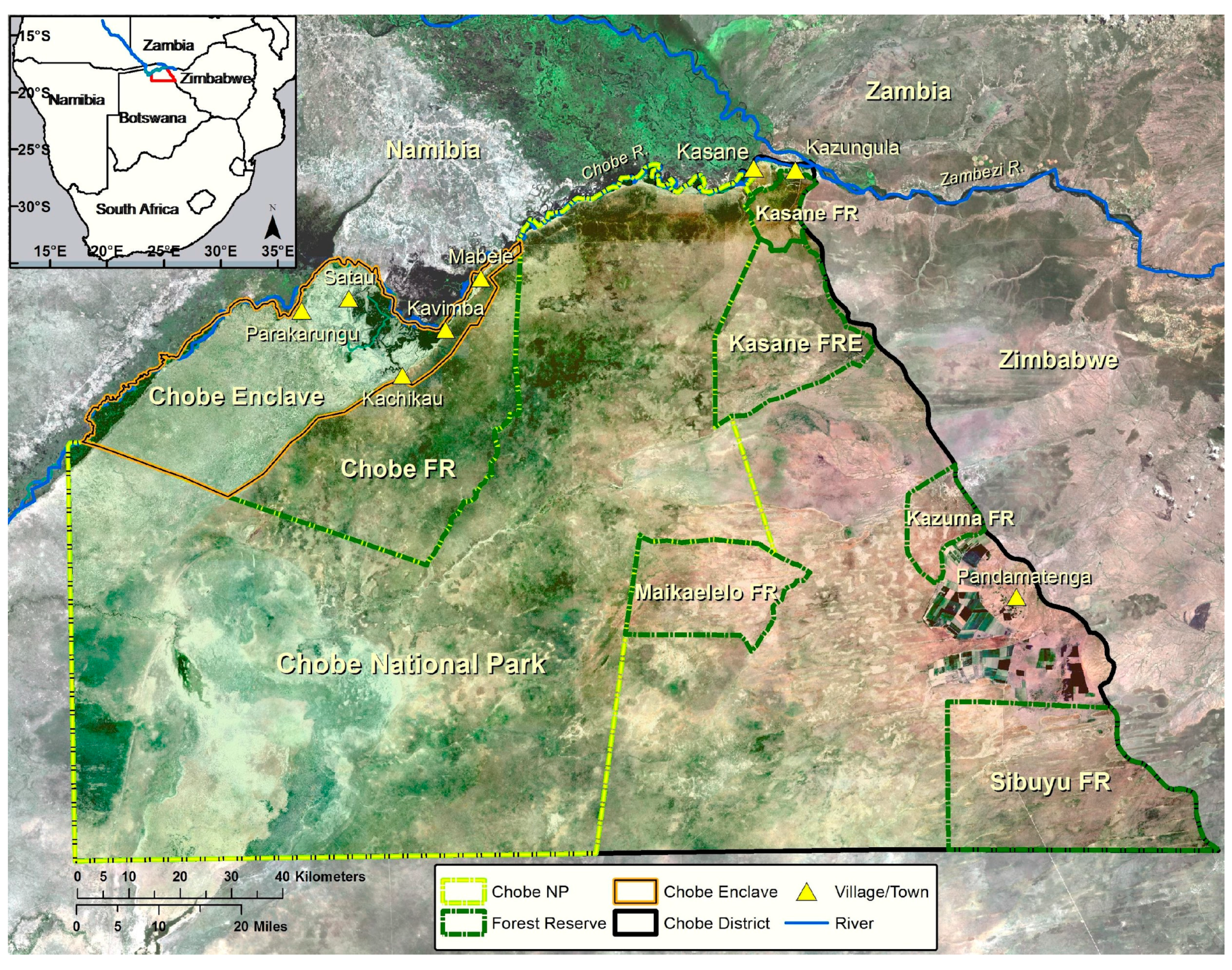

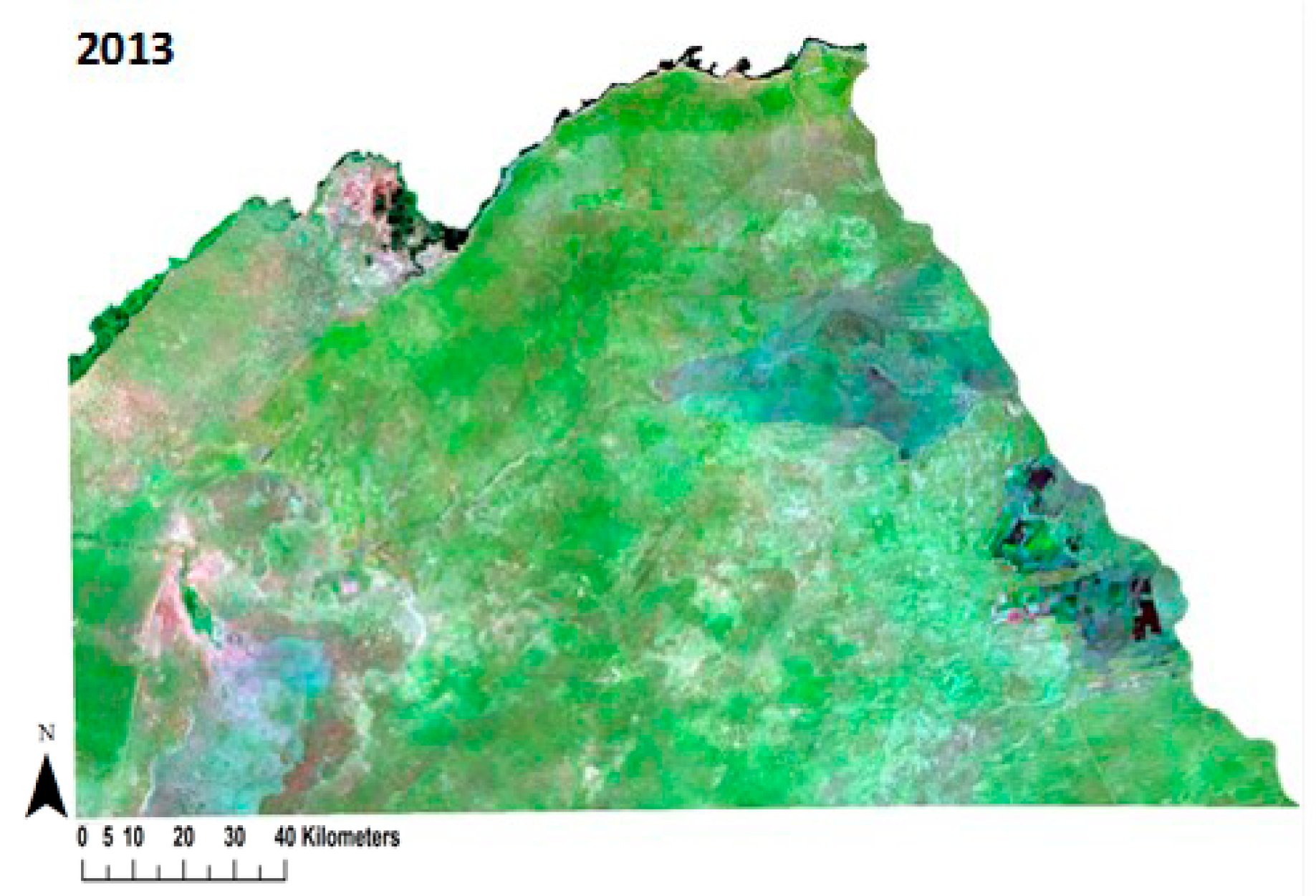
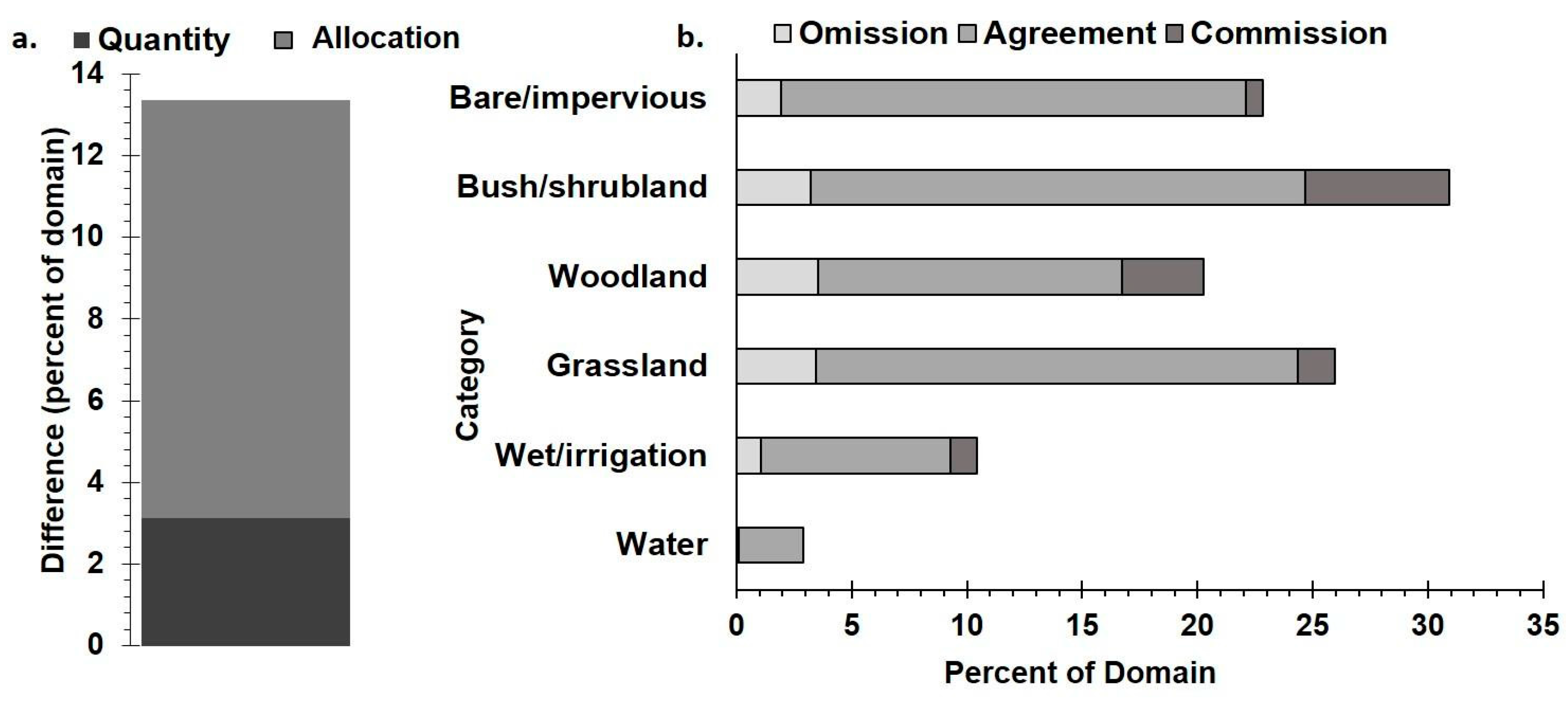



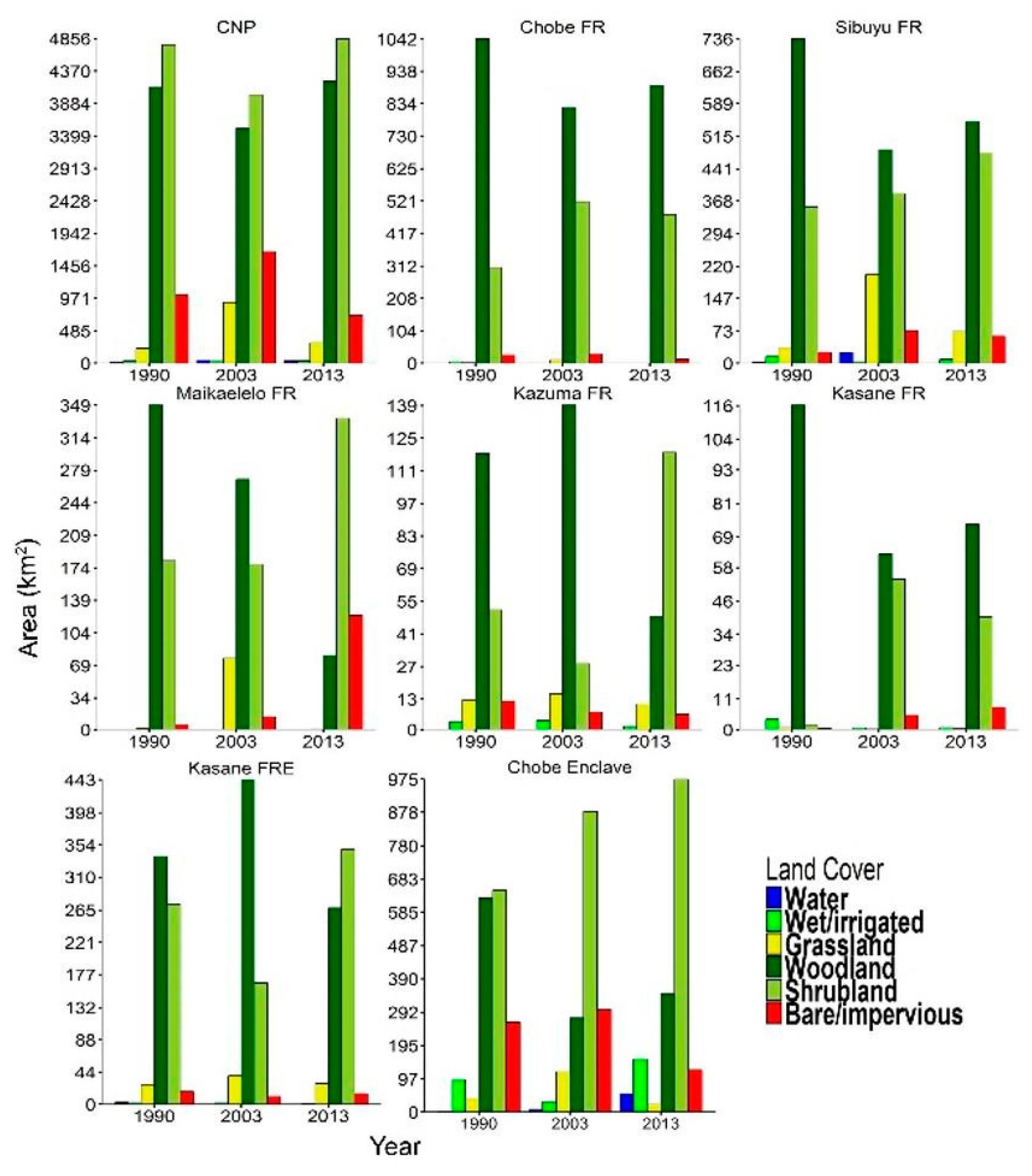

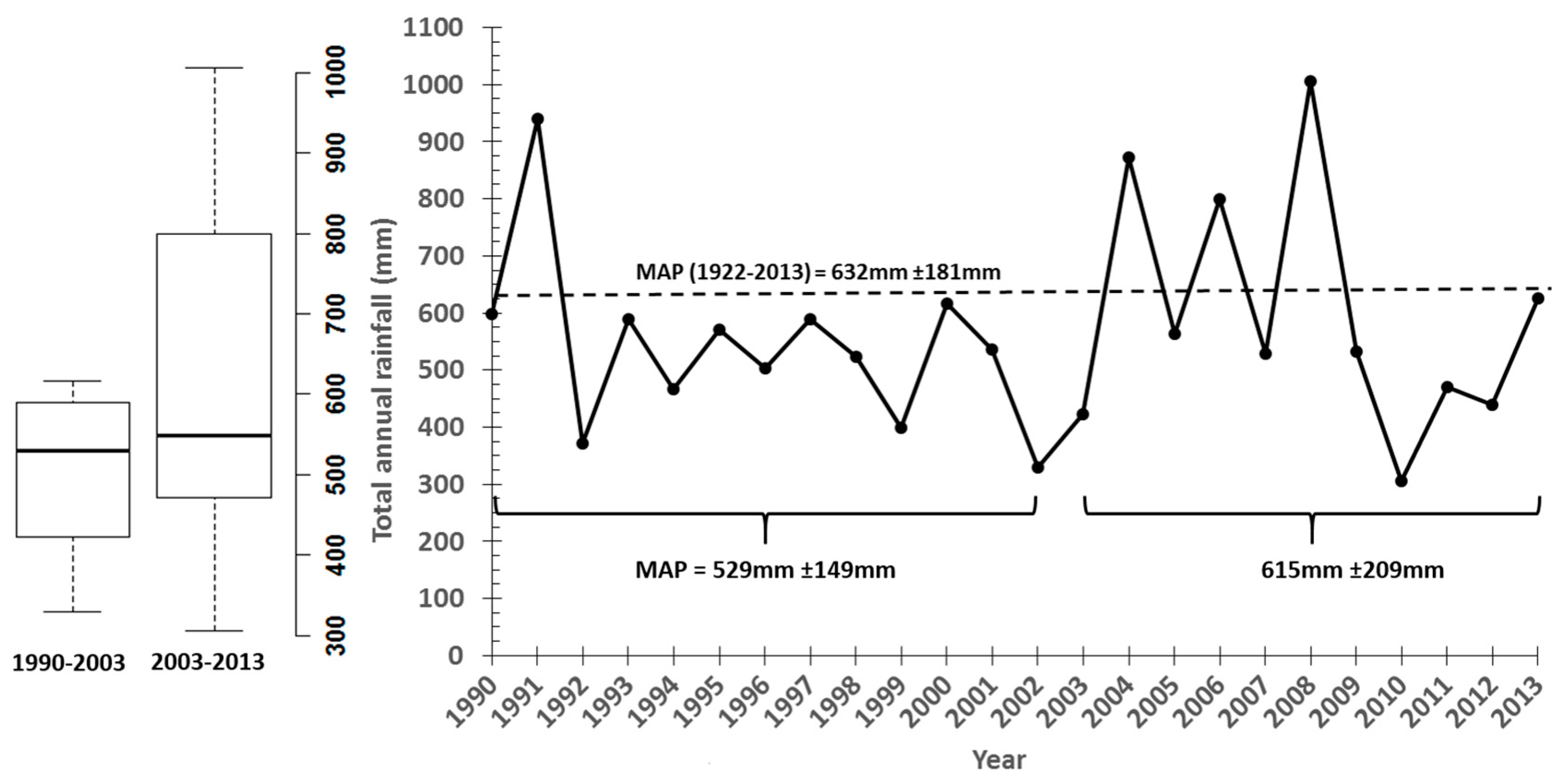
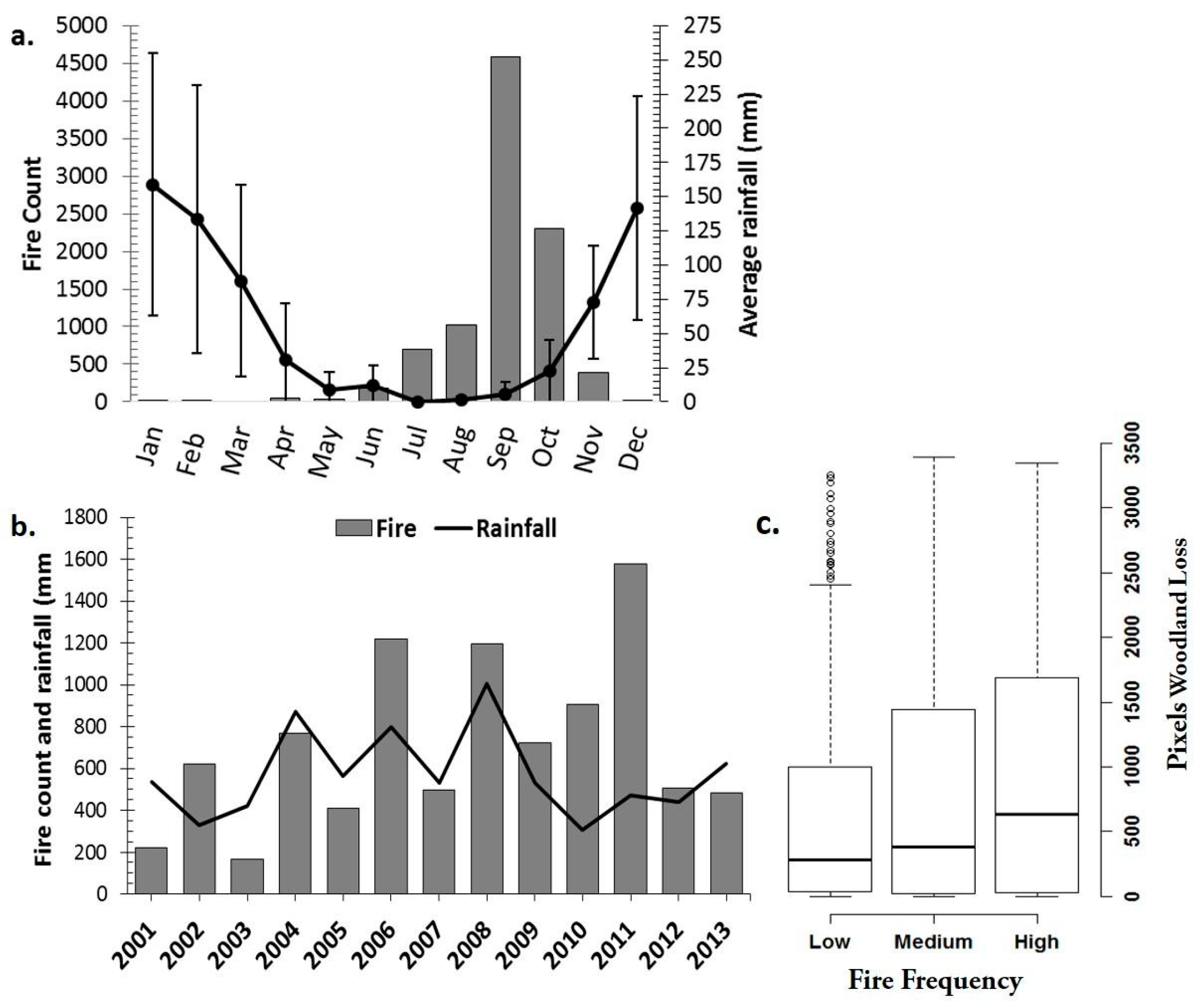

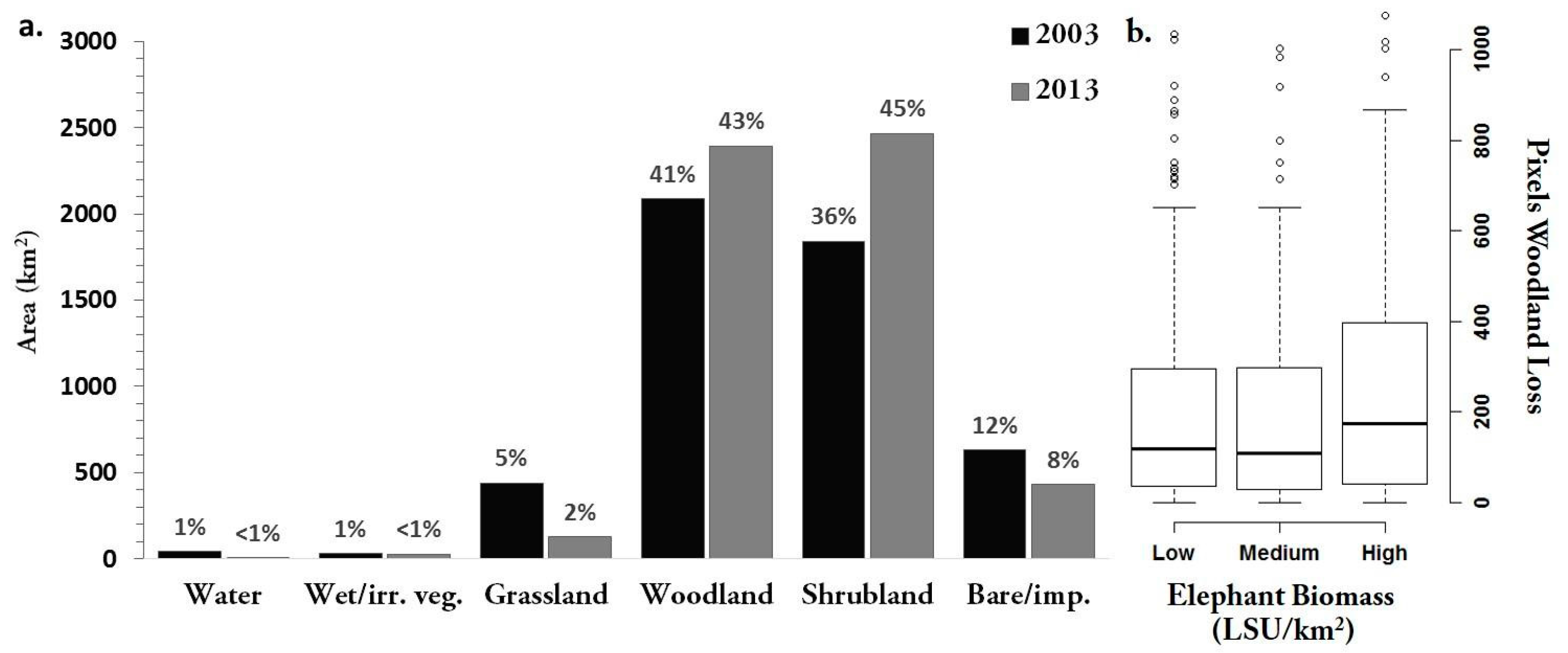
| Class | Description |
|---|---|
| Water | Perennial and seasonally-flooded river channels, water-filled pans, reservoirs, and watering holes |
| Wet/irrigated vegetation | Permanent and seasonally-inundated wetland, floodplain, and riparian vegetation; irrigated agricultural land, and water-saturated vegetation surrounding ephemeral water pans. |
| Grassland | Land cover dominated by grasses with <10% tree and shrub cover. |
| Woodland | Land with tree cover ranging from open (>10%) tree savanna intermixed with a grass or shrub understory, to closed-canopy (>40% cover) dry deciduous forest. |
| Shrubland | Land cover dominated by mixed, short woody vegetation (usually <3 m tall) ranging from open shrub savanna (>10% cover) with a discontinuous understory cover of annual grasses, herbs, and occasional tall trees, to thickets (>50%) with little or no grass cover. |
| Bare/impervious | Natural sandy and bare soils; rock outcrops; and impervious surfaces including dirt and tar roads, parking lots, and rooftops. |
| Location | Area (km2) | Mean Detection Confidence | Total Fires | Average Annual Fires | AFI |
|---|---|---|---|---|---|
| Chobe District | 21,153 | 91 | 9288 | 714 | 3.4 |
| Chobe Enclave | 1677 | 89 | 1128 | 87 | 5.2 |
| Protected Area | |||||
| Chobe NP | 10,168 | 92 | 2835 | 218 | 2.1 |
| Chobe FR | 1382 | 89 | 326 | 25 | 1.8 |
| Sibuyu FR | 1169 | 92 | 726 | 56 | 4.8 |
| Kasane FRE | 660 | 90 | 613 | 47 | 7.1 |
| Maikaelelo FR | 538 | 91 | 310 | 24 | 4.4 |
| Kazuma FR | 194 | 91 | 151 | 12 | 6.0 |
| Kasane FR | 123 | 92 | 33 | 3 | 2.1 |
| Variable | Woodland Loss | |
|---|---|---|
| Intercept | 10.77 ** | 19.94 ** |
| df | 846 | 1257 |
| Medium elephant biomass | 0.002 | - |
| High elephant biomass | 0.008 | - |
| Medium fire | - | 1.58 |
| High fire | - | 5.31 |
| Variogram Form | Rational quadratic | Exponential |
| Range | 0.002 | 0.03 |
| Nugget | <0.01 | 0.66 |
| Residual standard error | 6.49 | 17.07 |
© 2017 by the authors. Licensee MDPI, Basel, Switzerland. This article is an open access article distributed under the terms and conditions of the Creative Commons Attribution (CC BY) license (http://creativecommons.org/licenses/by/4.0/).
Share and Cite
Fox, J.T.; Vandewalle, M.E.; Alexander, K.A. Land Cover Change in Northern Botswana: The Influence of Climate, Fire, and Elephants on Semi-Arid Savanna Woodlands. Land 2017, 6, 73. https://doi.org/10.3390/land6040073
Fox JT, Vandewalle ME, Alexander KA. Land Cover Change in Northern Botswana: The Influence of Climate, Fire, and Elephants on Semi-Arid Savanna Woodlands. Land. 2017; 6(4):73. https://doi.org/10.3390/land6040073
Chicago/Turabian StyleFox, John Tyler, Mark E. Vandewalle, and Kathleen A. Alexander. 2017. "Land Cover Change in Northern Botswana: The Influence of Climate, Fire, and Elephants on Semi-Arid Savanna Woodlands" Land 6, no. 4: 73. https://doi.org/10.3390/land6040073
APA StyleFox, J. T., Vandewalle, M. E., & Alexander, K. A. (2017). Land Cover Change in Northern Botswana: The Influence of Climate, Fire, and Elephants on Semi-Arid Savanna Woodlands. Land, 6(4), 73. https://doi.org/10.3390/land6040073






